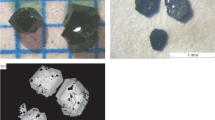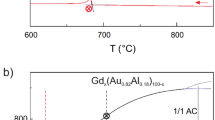Conclusions
Single crystal specimens of GdB6 free from inclusions of the tetraboride phase were produced. This was achieved using a shielding medium with a relatively low excess pressure of argon ensuring at the same time the high homogeneity of the melt of the zone as a result of intensive stirring.
Because of the high work function of the electron of GdB6 and the instability of this phase at high temperatures, this material is not interesting as a thermoemitter of the electrons. On the other hand, it is desirable to examine in greater detail the tetraboride phase whose thermoemission properties may prove to be considerably higher than those of the hexaboride phase.
The region of antiferromagnetic ordering (15.2°K) was characterized by a large jump of the specific electrical resistivity which characterizes the structural phase transformation. At T ∿ 7–10°K an additional anomaly of the resistivity accompanied by a temperature hysteresis was detected.
Similar content being viewed by others
Literature cited
G. V. Samsonov and Yu. B. Paderno, Borides of Rare-Earth Metals [in Russian], Academy of Sciences of the Ukrainian SSR, Kiev (1961).
G. A. Kudintseva and B. M. Tsarev, “Emission properties of hexaborides of certain rare-earth metals,” Radiotekh. Élektron.,3, No. 3, 428–429 (1958).
B. R. Coles, T. Cole, J. Lambe, and N. Zaurance, “Electrical resistivity and paramagnetic resonance in gadolinium hexaboride,” Proc. Phys. Soc.,79, No. 507, 84–86 (1982).
T. Tanaka, R. Nishitaki, and C. Oshima, “The preparation and properties of CeB6, SmB6, and GdB6,” J. Appl. Phys.,51, No. 7, 3877–3883 (1980).
Yu. B. Paderno, V. I. Lazrenko, and A. V. Kovalev, “Zonal purification and growth of single crystals of lanthanum hexaboride,” Poroshk. Metall., No. 10, 60–65 (1981).
K. E. Spear, Phase Diagrams. Material Science and Technology, Vol. 4, Academic Press, New York (1976).
W. Pfann, Zonal Melting [Russian translation], Mir, Moscow (1970).
A. V. Tkach and Yu. B. Paderno, “Electrochemical behavior of powders of borides of REE added to the composition of a carbon paste electrode,” Dokl. Akad. Nauk Ukr. SSR, Ser. B, No. 9, 50–52 (1984).
M. Futamoto, M. Nakazawa, and U. Kawabe, “Thermionic emission properties of hexaborides,” Surf. Sci.,100, No. 3, 470–480 (1980).
L. W. Swanson and D. R. McNeely, “Work function of the (001) face of the hexaborides of barium, lanthanum, cerium and samarium,” Surf. Sci.,83, No. 1, 11–28 (1979).
Author information
Authors and Affiliations
Additional information
Translated from Poroshkovaya Metallurgiya, No. 7(319), pp. 54–59, July, 1989.
Rights and permissions
About this article
Cite this article
Lazorenko, V.I., Siman, N.I., Dmitriev, A.I. et al. Growth of single crystals of GdB6 and examination of their properties. Powder Metall Met Ceram 28, 555–559 (1989). https://doi.org/10.1007/BF00794870
Received:
Issue Date:
DOI: https://doi.org/10.1007/BF00794870




